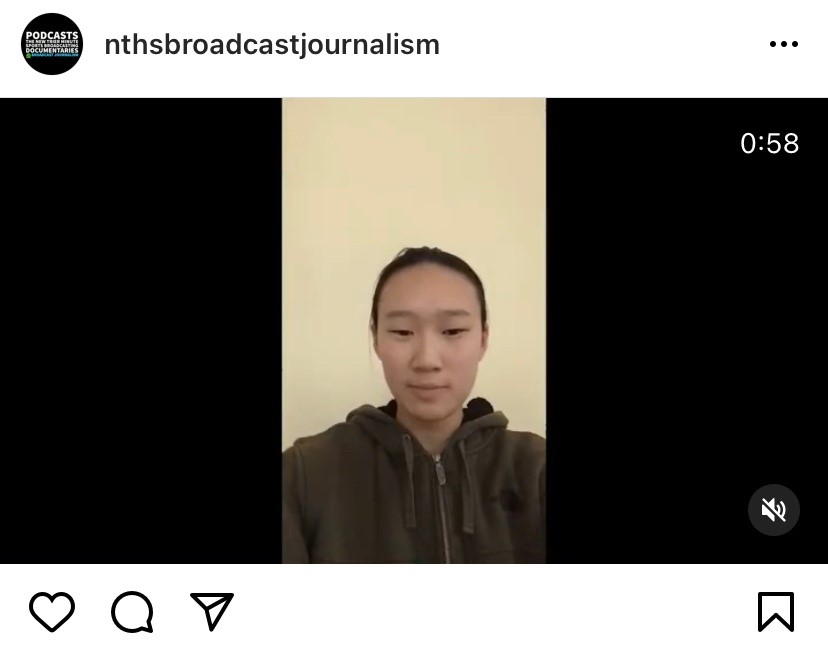“60 Minutes?” How about New Trier’s 60 Seconds?
Broadcast Journalism students deliver everything you need to know about the latest news stories in a brief 60 seconds
New Trier Minute
Sophomore Jack Gong discusses the coronavirus’ effect on the economy in the New Trier Minute’s first episode, “The Struggle Continues,” which was posted on Dec. 7
In her home office, sophomore and Broadcast Journalism student Margo Pagonis sets up her iPad on a tripod so it is at eye level. Two bookcases stand in the background, equidistant from where she will be herself, creating a nice symmetry. Pagonis opens her teleprompter app and does a quick test-run with it. She double checks that everything is as it should be: framing, lighting, and sound. She inhales deeply and exhales. She now feels calm, collected, and ready. She presses the record button on her iPad and begins.
Last school year, James Syrek, the Broadcast Journalism teacher, was “looking for a platform…to bring news to students in the community that reflected how we consume news.” He found that the best way to offer this short and concise news outlet would be through the internet and social media. So, the New Trier Minute was born.
The New Trier Minute is a daily 60-second news show posted onto Broadcast Journalism’s Instagram. Each episode of the show explores one story and contains only the story’s most valuable information.
“Each week we get different topics. We get to produce everything ourselves,” said sophomore and Broadcast Journalism student Aimee Fawley.
“It’s a very student-centered, hands-on approach,” said Syrek, “I am there to provide support and feedback and help their video reports get to a place where they’re ready to be published.”
Every two weeks, the class is randomly divided into teams of two with one remaining student who works more closely with Syrek as the show producer.
Within the teams of two, one student is the designated script writer while the other films and edits the video.
As for the show producer, according to Syrek, they “oversee the development and the deadlines of every episode, for every week, and provide us support and encouragement.”
At the beginning of the process, Syrek assigns the class a broad topic, such as looking forward to 2021. Then, he releases the teams into breakout rooms where each team chooses the topics it wants.
“It’s a very wide range of topics,” said sophomore Daniel Stein, one of Syrek’s students, “We try to think a little bit outside the box.”
Some of the topics have included the history of Monday Night Football, stimulus checks and Americans’ financial struggles with COVID, and the school’s production of It’s A Wonderful Life.
For their research, the class uses sources such as the school’s databases, other news outlets, and their own general knowledge.
The script writers strive to use trusted sources that consistently put out accurate information.
“We do try and make sure that our sources are unbiased because we’re just trying to kind of put facts down,” said Pagonis.
So far, some students have found it tough to condense stories into 60-second video clips.
“It’s very hard,” said Fawley, “because you want to keep it very fact-based and have as much information in there as possible without running out of time or being one-sided.”
Syrek has instructed his students to film in a space that has good lighting with the iPad at eye level. When filming, students use a teleprompter app to read their script.
“I use PromptSmart Pro,” said Pagonis, “You say the words and the app detects your voice, and it goes along so it looks like you’re looking at the camera not the script.”
“You just have to have a sense of confidence, but also you’re not talking like a robot. You have to speak in sort of a conversationalist way but your script has to be formal enough where you get your point across quickly,” said Stein.
To advertise the New Trier Minute, the Broadcast Journalism class relies on word of mouth and social media.
“We do a lot of interviewing of community members. We do a lot of interviewing of teachers. We do a lot of talking to alumni, coaches, and athletes,” said Syrek, “And they help us, in turn, promote what we do because they’re a part of what we do.”
Several members of the class post their reports to their personal Instagram accounts.
In addition, the New Trier Minute is being promoted on the Broadcast Journalism’s Twitter and Instagram accounts, WNTH Radio, and the school’s Instagram page.
“I hope that we can really share stories that are worth telling and create a little news team because I think it’s really cool to have a real news station going, even at a smaller level,” said Pagonis.







































